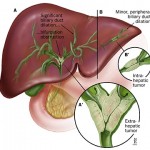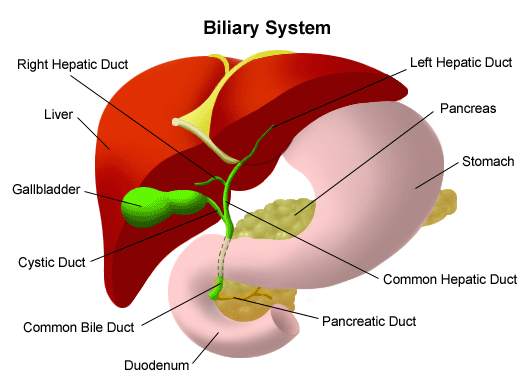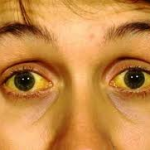The bile ducts are tubes that carry bile. The main function of bile is to break down fats in food to help our digestion. Bile is made by the liver and stored in the gall bladder.
 The bile ducts connect the liver and the gall bladder to the small bowel. When people have had their gall bladder removed, bile flows directly from the liver into the small intestine.
The bile ducts connect the liver and the gall bladder to the small bowel. When people have had their gall bladder removed, bile flows directly from the liver into the small intestine.
The bile ducts and gall bladder are known as the biliary system.
Cholangiocarcinoma is a cancerous (malignant) growth in one of the ducts that carries bile from the liver to the small intestine.
Causes, incidence, and risk factors
Cancerous tumors of the bile ducts are usually slow-growing and do not spread (metastasize) quickly. However, many of these tumors are already advanced by the time they are found.
A cholangiocarcinoma may start anywhere along the bile ducts. These tumors block off the bile ducts.
They affect both men and women. Most patients are older than 65.
Risks for this condition include:
- Bile duct (choledochal) cysts
- Chronic biliary irritation
- History of infection with the parasitic worm, liver flukes
- Primary sclerosing cholangitis
- Inflammatory bowel disease. People who have a chronic inflammatory bowel condition known as ulcerative colitis have an increased risk of developing this type of cancer.
- Abnormal bile ducts. People who are born with (congenital) abnormalities of the bile ducts, such as choledochal cysts, have a higher risk of developing cholangiocarcinoma.
- Increasing age. Although bile duct cancers can occur in younger people, more than two out of three occur in people over the age of 65.
Cholangiocarcinoma is rare. It occurs in approximately 2 out of 100,000 people.
 Symptoms
Symptoms
- Chills
- Clay-colored stools
- Fever
- Itching
- Loss of appetite
- Pain in the upper right abdomen that may radiate to the back.
- Weight loss
- Yellowing of the skin (jaundice). Cancer in the bile ducts can block the flow of bile from the liver to the intestine. This causes bile to flow back into the blood and body tissues, and the skin and whites of the eyes to become yellow (jaundiced).
Signs and tests
Your health care provider will perform a physical exam. Tests will be done to check for a tumor or blockage in the bile duct. These may include:
- Abdominal CT scan. A CT scan takes a series of x-rays that build up a three-dimensional picture of the inside of the body. The scan is painless and takes 10–30 minutes. CT scans use small amounts of radiation that are very unlikely to hurt you or anyone you come in contact with. You’ll be asked not to eat or drink for at least four hours before the scan.
You may be given a drink or injection of a dye that allows particular areas to be seen more clearly. For a few minutes, this may make you feel hot all over. If you are allergic to iodine or have asthma you could have a more serious reaction to the injection, so it’s important to let your doctor know beforehand.
- Abdominal ultrasound. This uses sound waves to make up a picture of     the bile ducts and surrounding organs. You’ll usually be asked not to eat or drink anything for at least six hours before the scan. Once you are lying comfortably on your back, a gel is spread onto your abdomen. A small  device that produces sound waves is then rubbed over the area. The sound waves produce a picture on a computer. The test is painless and only takes  a few minutes.
- CT scan-directed biopsy
- Cytology
- Endoscopic retrograde cholangiopancreatography (ERCP)
- Magnetic resonance cholangiopancreatography (MRCP)
- Percutaneous transhepatic cholangiogram (PTCA)
Blood tests that may be done include:
- Liver function tests (especially alkaline phosphatase or bilirubin levels)
Treatment
The goal is to treat the cancer and the blockage it causes. When possible, surgery to remove the tumor is the treatment of choice and may result in a cure. If the tumor is large, the entire liver may need to be removed and a liver transplant will be needed. However, often the cancer has already spread by the time it is diagnosed.
Chemotherapy or radiation may be given after surgery to decrease the risk of the cancer returning. However, the benefit of this treatment is not certain.
Endoscopic therapy with stent placement can temporarily relieve blockages in the biliary ducts and relieve jaundice in patients when the tumor cannot be removed. Laser therapy combined with light-activated chemotherapy medications is another treatment option for those with blockages of the bile duct.
Support Groups
You can ease the stress of illness by joining a support group with members who share common experiences and problems. Hospice is often a good resource for patients with cholangiocarcinoma that cannot be cured.
Expectations (prognosis)
Completely removing the tumor allows 30 – 40% of patients to survive for at least 5 years, with the possibility of a complete cure.
If the tumor cannot be completely removed, a cure is generally not possible. With treatment, about half of these patients live a year, and about half live longer.
Complications
- Infection
- Liver failure
- Spread (metastasis) of tumor to other organs
Calling your health care provider
Call your health care provider if you have jaundice or other symptoms of cholangiocarcinoma.

